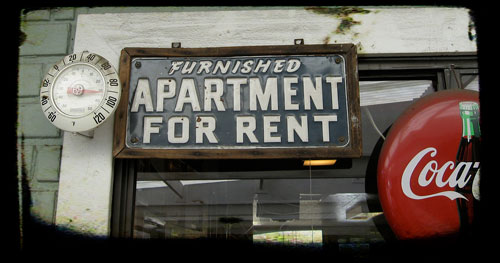Editor’s note: Today’s issue is created in partnership with the folks at Make Room, a nonpartisan organization sponsored by the housing nonprofit Enterprise Community Partners.
Today in Tedium: There’s a lot of country hiding between New York and San Francisco, but for some reason, these two cities dominate discussions about rent prices in the United States. It’s understandable. It’s pretty easy for your eyes to pop when you read about a 1-bedroom apartment’s price topping $3,500, as ApartmentList reported about San Francisco earlier this month. But what about the rest of the country? Are things out of whack, and how do we get them back into whack? That’s a complicated question to answer, but today’s Tedium tries its best to answer it. — Ernie @ Tedium

Make Room gives voice to struggling renters and elevates rental housing on the agendas of our nation’s leaders. We’re advocating for better policies and telling the stories of real families who can’t make rent today.
Today's issue is sponsored by Make Room. (You can sponsor us, too.)
1.3M
The anticipated number of newly housing-insecure renters over the next decade, according to projections by the Enterprise and the Joint Center for Housing Studies. And that’s only if rent growth matches the expansion in income. That traditionally hasn’t been the case.

If you compare historic rents to the rate of inflation, something startling emerges
Shelter is an essential thing—up there with food and water. But while those other essentials remain relatively inexpensive, the cost of a proper housing has surged over the years.
But to really get a grasp of how dramatic this surge has been, it helps to look in a historic context: How far would a 1940s-level rent get you nowadays?
In 2013, the real estate blog Curbed pondered this question, by doing an analysis of rent based on historic Village Voice classified ads. In the 1940s, a New York City apartment in a decent neighborhood could be had for about $50. What would that $50 get you now?
In the 1940s, you could get a place on the Lower East Side for less than $50, according to the analysis. These days, with inflation considered, that $50 equals out to between $780 and $830. The average rent in NYC is $3,800—and that $800 or so will barely even get you a shared apartment.
"To find a private apartment for the same $800 price range, one must go to the far reaches of the city," the website’s Jessica Dailey wrote.
But even outside of New York, rental rates have traditionally outpaced the rate of inflation. Between 2010 and 2014, U.S. Census Bureau reported the median gross rent nationwide to be $920. In comparison, the pre-inflation rate of rent in 1940 was $27—an amount that would have been the equivalent of $456 in 2014.
Sure, plenty of things have changed since then—our definition of basic utilities has expanded to include cable television and internet, we expect air conditioning, and there are tougher regulatory and maintenance standards than there were 76 years ago. But when it comes down to it, the price of rent nationally has more than doubled.
Even in states with rents below the national average, the increase has been fairly dramatic. In 1940, for example, Mississippi was the least expensive place to rent in the country, with places going for an average of $11 per month, or $186.01 in 2014 numbers. That year, the median rent in Mississippi tallies at $714, nearly four times as much as the inflation-adjusted 1940 rent could buy. (And no, Mississippi is no longer the cheapest state to rent in; that honor goes to West Virginia, or if you want to expand to official U.S. territories, Puerto Rico.)
Certainly, cheap rents can still be found in some places—if you’re willing to live in Toledo, Ohio, you can get an apartment for $638 per month, making it the lowest rent in the country in a city with a population topping 250,000, according to American Community Survey estimates gathered by FindTheHome. Problem is, the per-capita income in that area is $19,113—meaning that the rent would account for 40 percent of the average Toledo resident’s income if they were living by themselves.
Plenty of people in Toledo probably make a lot more than $19,113. But plenty more probably make less. And looking at things in recent terms highlights just how problematic this trend really is.
21.3M
The number of households that spent more than 30 percent of their income on rent in 2014, according to research by Enterprise Community Partners and the Joint Center for Housing Studies—a level that is considered "moderately rent burdened." Of those, 11.4 million household spend more than half of their income on rent—a level considered “housing insecure.”

Why things are so out-of-whack for renters
"Affordable housing" is often bandied about as a buzzword in the world of real estate, despite the fact that it’s considered essential for many socioeconomic groups by the U.S. Department of Housing and Urban Development.
The problem is, it’s often not reflected on the ground. In some ways, it feels like a myth, like you’re given a set of options—safe, inexpensive, convenient, sizable—and told to choose just two. You’re more likely to see an ad for a fancy apartment you can’t afford on your just-scraping-by salary than one that’s suited for your needs.
Now, here’s the crazy thing about this: The federal government has a set of metrics set aside that are supposed to allow for rental assistance for people who need it—in the form of Section 8 rental assistance vouchers and Low-Income Housing Tax Credits. These programs keep people in their homes, and bring a bit of stability to what can often feel like a losing situation. When income isn’t inflating as fast as rent is, this kind of help can be a lifesaver.
The problem is, just 23 percent of Americans who qualify for such programs actually receive this help, according to the National Bureau of Economic Research. Part of the problem is funding, part of it is legislative will.
Slightly higher up the economic food chain, the U.S. government actually assists people with housing on a fairly consistent basis. These programs have definite value—they put homeownership within reach of people who otherwise couldn’t afford it, but the problem is that the calibration is somewhat out of whack: Households that make more than $100,000 per year are much more likely to receive home mortgage interest and property tax deductions than those that make less than that. In fact, three-quarters of these subsidies go to households that make more than $100,000, and more than a third to households with incomes above $200,000.
This year, the federal government will put $140 billion into programs designed to help homeowners. It’ll put just $55 billion into programs designed to help renters. In an era when renting is becoming more common, the gap raises way too many questions.
Anyone who’s lived in a city knows that the vibe and overall culture of that city is the sum of its parts. You lose that vibrancy when everyone who wants to live there can’t. By putting most of the weight of housing policy on ownership rather than rental, it limits the community’s long-term potential.
And that’s a bummer—the person pouring your drink deserves an easy commute just as much as the person who owns the bar.
Houses are great investments. If you can knock out a 30-year mortgage, you’ll eventually have something that’s in your name that holds immense value. But sometimes, purchasing a home isn’t a good option. Say, for example, your chosen career path as the next Lin-Manuel Miranda means you’ll have to spend some time as a starving artist before you can sell out Broadway night after night and make a star turn on Saturday Night Live. Or maybe you have a career path that requires you to move every couple of years.
Or maybe you’re on a lower socioeconomic tier than other people in your community, and the idea of buying a house feels like a pipe dream. If the rent is too freaking high, how are you ever going to get ahead?
Let’s put this another way: You’re familiar with the concept of subprime mortgages, right? Well, those who found themselves underwater as a result of bad mortgages, guess where they went to live after their house was foreclosed upon? I’ll give you a hint: They most likely didn’t purchase another home after that. They probably went back to renting.
In fact, the numbers back this up: The U.S. homeownership rate has fallen sharply since 2004, with the U.S. Census Bureau reporting back in July that the homeownership rate during the second quarter of 2016 was 62.9 percent—a nadir not seen in 51 years. Meanwhile, renting has become much more common—as CityLab's Richard Florida reported back in February that the trend has sharply favored the renter, especially among millennials, with the rental rate among 18 to 34-year-olds sitting at 71.6 percent in 2014—a jump of roughly 9 percent from 2016.
The federal government has long helped homeowners pay for their homes through subsidies and other forms of assistance. Now, if it’s a renter’s market, why isn’t the federal government—or heck, why aren’t state and local governments, which have a more direct effect on local market rates—doing more to help renters?
What can we do to change this? We can start by sending a message to federal, state, and local representatives. These are the officials we’ve elected into power—we need to hold them accountable to address this crisis and start to put policies into place that work.
Let's face it: The odds are good that if you're feeling the pain of high rents, so are most of your friends. Why shouldn't you speak up?




